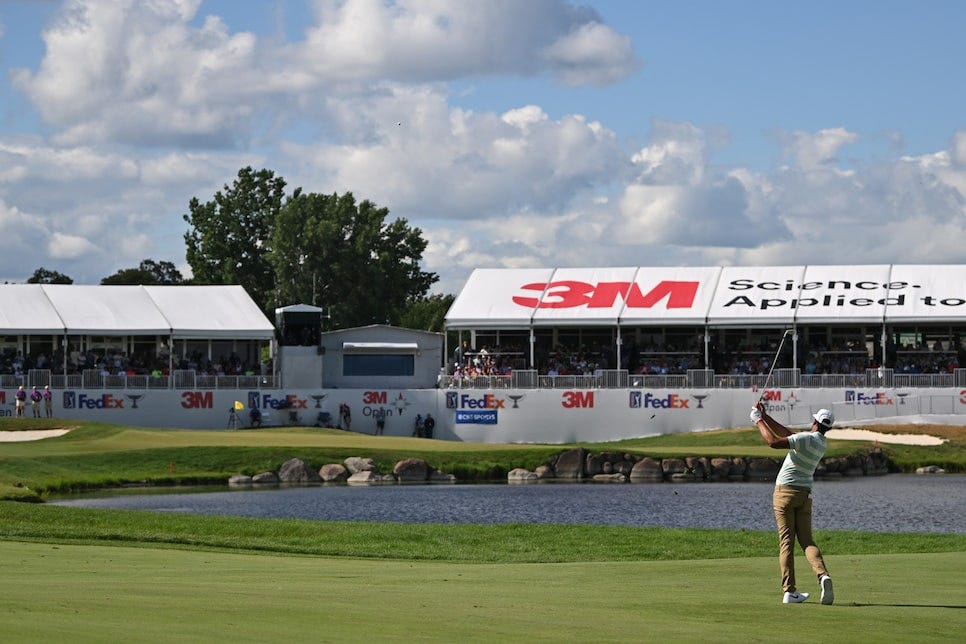3M Open Preview: TPC Twin Cities
Our resident golf handicapper "Rainman Maroochi" makes his highly anticipated debut..
TPC Twin Cities – Course Details
• Location: Blaine, Minnesota (north of Minneapolis–St. Paul)
• Designer: Arnold Palmer (with Tom Lehman consulting)
• Opened: 2000
• Par: 71
• Yardage: Approximately 7,431 yards
• Greens: Bentgrass
• Fairways: Bentgrass
• Rough: Kentucky bluegrass
• Water Hazards: In play on 15 of 18 holes
• Style: Parkland course with wide fairways and penal water hazards
• Signature Hole: No. 18 – Risk-reward par 5 with water guarding the entire left side
• Scoring Range: Winning scores typically between -15 to -24
• Key Skills Required: Ball-striking, par-5 scoring
Coming off of Scottie Scheffler’s dominant display at The Open Championship, we now shift gears and try to shake off the major hangover as the PGA Tour heads to Blaine, Minnesota, for the 3M Open. The transition from the intensity of a major to a lower-profile event like this can be tricky—not just for fans, but for the players themselves. It!ll be interesting to see how many can quickly recalibrate their form and contend on a very different layout.
Course Overview – TPC Twin Cities
The 3M Open is held at TPC Twin Cities, just north of Minneapolis in Blaine, Minnesota. Designed by Arnold Palmer with consultation from Tom Lehman, this Par 71 stretches out to just over 7,400 yards. While it may not be a major championship venue, it has enough bite to challenge players—largely thanks to the ever-present threat of water. Water hazards come into play on 15 of the 18 holes, which theoretically should put a premium on accuracy over distance. The idea being: avoid the big numbers by avoiding the big misses. But interestingly, that hasn’t always played out in the winner!s circle. Players like CameronChamp and Jhonattan Vegas—known more for power than precision—have triumphed here, showing that length can still be a valuable weapon if paired with timely iron play and a hot putter. This contrast raises an interesting question: Should TPC Twin Cities reward the accurate, or does raw power still carry the edge? What is clear, though, is that the course increases variance. The abundance of water and risk-reward opportunities means players are always walking a tightrope. We’ve seen examples of this volatility: Lee Hodges won here in 2023 in dominant fashion, but returned the following year and missed the cut entirely. The bentgrass greens are large and typically receptive, allowing for aggressive approach play when conditions are soft. But the rough—made up of Kentucky bluegrass—can make scrambling and recovery difficult, especially if players get out of position off the tee. While the course is scoreable—with winning scores often in the -17 to -24 range—it demands respect. The leaderboard often features players who can combine length with just enough control, and those who can manage the momentum swings that the layout inevitably brings.
🔍 Model-Based Picks: Key Profiles That Fit
Using a custom model focused on:
• Driving Distance
• Mid-to-Long Iron Play
• Low reliance on short game & putting
Here are several players who stand out as strong fits:
• Kurt Kitayama (40-1) – Big-hitting, streaky iron player with the ability to spike.
• Rico Hoey (55-1) – Sneaky strong ball striker who profiles well statistically.
• Luke Clanton (66-1) – The college standout is gaining steam, and this could be his breakthrough.
• Michael Thorbjornsen (35-1) – Rising star with high level ball-striking talent.
• Cameron Champ (50-1) – Former winner here, power + streaky approach play = upside.
• Lee Hodges (70-1) – 2023 champ, good long-iron profile despite putting limitations.
• Davis Thompson (45-1) – Trending with ball striking and can handle scoring fests.
🏆 Your Winner: Taylor Pendrith (33-1)
One name rises above the rest this week: Taylor Pendrith. He missed the cut at The Open, which might be a blessing—he's had time to return, reset, and adjust to TPC Twin Cities. His ball-striking numbers have been excellent in 2024, especially his combination of elite driving distance and strong approach play from 175–200+ yards. What separates Pendrith from many of the other "team no putt" names on this list is his ability to putt when needed. On a course where the greens won’t demand much creativity, that could be the edge that gets him across the finish line.
Suggested Plays:
Taylor Pendrith (33-1): Risking 0.3 units to win approximately 10 units
Kurt Kitayama (40-1): Risking 0.15 units to win approximately 5 units
Rico Hoey (55-1): Risking 0.1 units to win approximately 5 units
Luke Clanton (66-1): Risking 0.08 units to win approximately 5 units
Michael Thorbjornsen (35-1): Risking 0.15 units to win approximately 5 units
Cameron Champ (50-1): Risking 0.1 units to win approximately 5 units
Lee Hodges (70-1): Risking 0.07 units to win approximately 5 units
Davis Thompson (45-1): Risking 0.1 units to win approximately 5 units
Total Risk Budget =1.05 units


